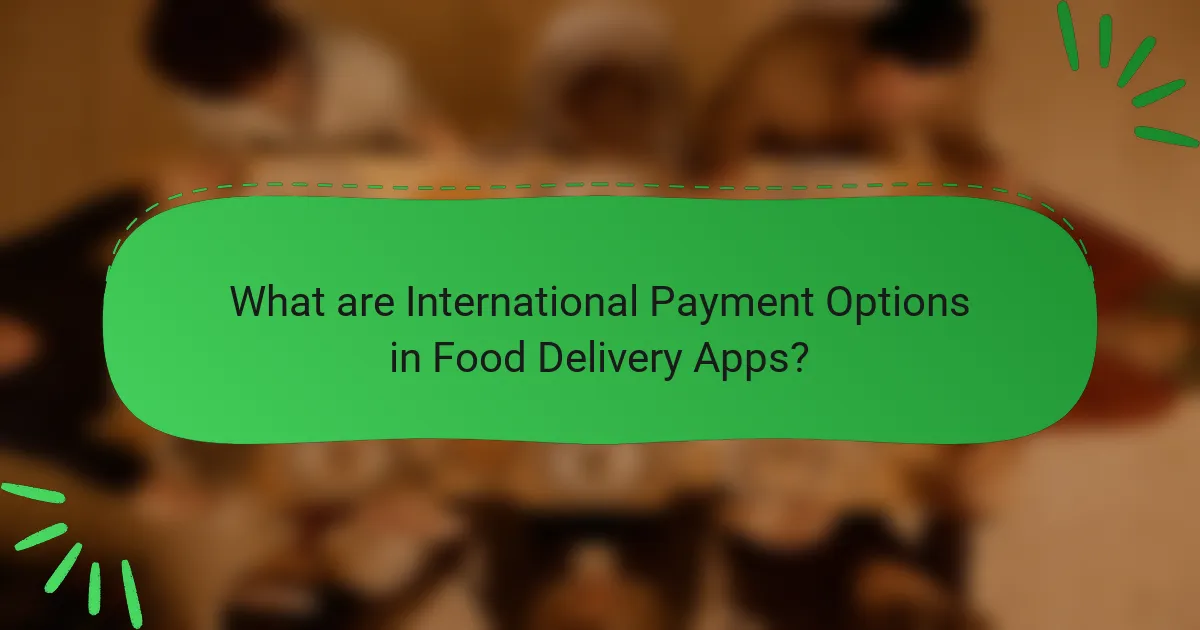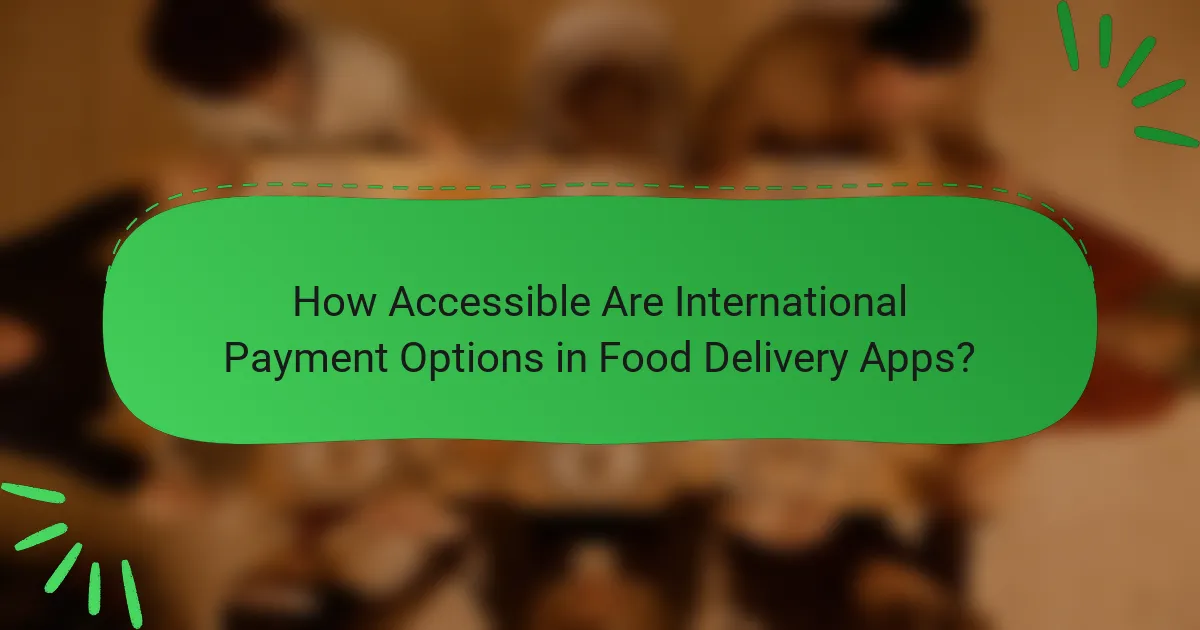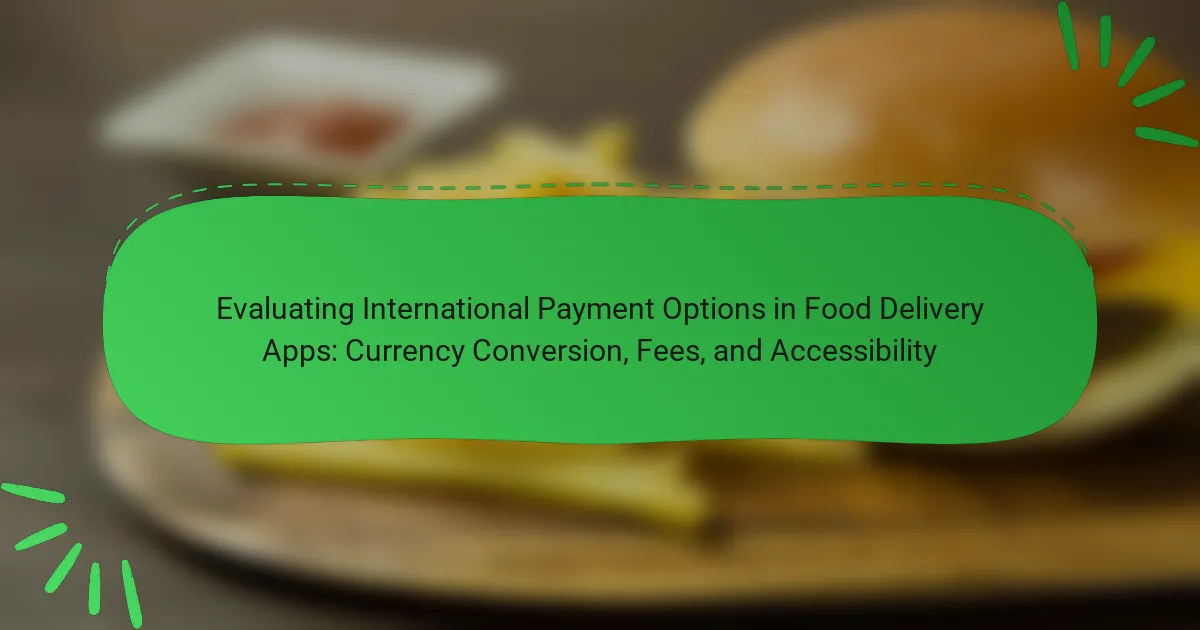International payment options in food delivery apps encompass various methods such as credit cards, digital wallets, and bank transfers, facilitating transactions in multiple currencies. Popular digital wallets like PayPal, Apple Pay, and Google Pay are commonly supported, along with local payment methods tailored to specific countries. Users should be aware of potential fees, including currency conversion, payment processing, and service fees, which can significantly impact the total order cost. While accessibility to these payment options is improving across major platforms like Uber Eats and DoorDash, it remains inconsistent by region and app. This article evaluates these international payment options, focusing on their currency conversion processes, associated fees, and overall accessibility for users.

What are International Payment Options in Food Delivery Apps?
International payment options in food delivery apps include credit cards, digital wallets, and bank transfers. These methods allow users to pay for services in various currencies. Popular digital wallets include PayPal, Apple Pay, and Google Pay. Many food delivery apps also support local payment methods specific to certain countries. Currency conversion is often handled automatically by the app. Fees may apply depending on the payment method used. Accessibility varies by region and app, impacting user experience. Major apps typically provide a selection of payment options to cater to international customers.
How do these payment options vary across different regions?
Payment options vary significantly across different regions due to local financial infrastructure and consumer preferences. In North America, credit and debit cards are the most common payment methods. Mobile wallets like Apple Pay and Google Pay are also widely used. In Europe, bank transfers and direct debit are popular alongside cards. Some countries in Europe favor local payment systems, like iDEAL in the Netherlands. In Asia, cash remains a dominant payment method, although mobile payment platforms like Alipay and WeChat Pay have gained popularity in China. In Africa, mobile money services such as M-Pesa are prevalent, particularly in countries like Kenya. These variations are influenced by factors such as regulatory environments, technological adoption, and cultural attitudes towards cash and digital payments.
What factors influence the availability of payment options in various countries?
The availability of payment options in various countries is influenced by several key factors. Regulatory frameworks govern financial transactions and can limit or expand payment methods. Economic stability affects consumer confidence and the adoption of digital payments. Cultural preferences shape the popularity of specific payment methods, such as cash versus digital options. Technological infrastructure determines the feasibility of online payment systems. Additionally, partnerships between payment providers and local businesses can enhance accessibility. Market competition also drives innovation and variety in payment solutions. For example, countries with robust fintech ecosystems typically offer more diverse payment options.
What role do local regulations play in shaping payment options?
Local regulations significantly influence payment options available to consumers. They establish legal frameworks that dictate which payment methods are permissible. For instance, some regions may mandate the acceptance of specific digital wallets or payment processors. Compliance with anti-money laundering laws also affects payment processing choices. Regulations can impose fees on transactions, impacting the overall cost for consumers and businesses. Additionally, local laws may require data protection measures, shaping how payment information is handled. These factors collectively determine the variety and accessibility of payment options in food delivery apps.
Why is Currency Conversion Important in Food Delivery Apps?
Currency conversion is important in food delivery apps to facilitate international transactions. It allows users to pay in their local currency, enhancing user experience. Accurate conversion rates ensure transparency in pricing. This builds trust between consumers and service providers. Furthermore, currency conversion can expand the app’s market reach. It attracts a diverse customer base from different countries. According to Statista, over 2.5 billion people globally use food delivery services. Thus, effective currency conversion is essential for capturing this audience.
How does currency conversion impact the overall cost for consumers?
Currency conversion directly affects the overall cost for consumers by altering the price they pay for goods and services. When consumers purchase items in a foreign currency, the exchange rate determines how much their local currency is worth in that context. Fluctuations in exchange rates can lead to higher or lower costs at the time of purchase. For example, if the exchange rate is unfavorable, consumers may end up paying significantly more than expected. Additionally, currency conversion fees imposed by banks or payment processors can further increase the total cost. These fees can range from 1% to 3% of the transaction amount, adding to the financial burden. Therefore, understanding currency conversion is essential for consumers to anticipate their spending accurately when engaging in international transactions.
What are the common methods for currency conversion in food delivery apps?
Common methods for currency conversion in food delivery apps include real-time exchange rates, manual currency selection, and integrated payment gateways. Real-time exchange rates automatically adjust prices based on current market values. This method ensures users pay the equivalent amount in their local currency. Manual currency selection allows users to choose their preferred currency before completing a transaction. Integrated payment gateways handle currency conversion automatically during the checkout process. These gateways often charge a small fee for the service. Many food delivery apps partner with financial institutions for accurate and efficient conversions. This partnership enhances user experience by reducing transaction times.

What Fees Are Associated with International Payments in Food Delivery Apps?
International payments in food delivery apps typically incur several fees. These fees include currency conversion fees, which are charged when transactions occur in a foreign currency. Payment processing fees are also common, as platforms charge for handling the transaction. Additionally, some apps may impose service fees for international orders.
For example, currency conversion fees can range from 1% to 3% of the transaction amount. Payment processors like PayPal or Stripe may charge around 2.9% plus a fixed fee per transaction. Service fees vary by app and can be a flat rate or a percentage of the order total.
These fees cumulatively affect the total cost of an order. Users should be aware of these potential charges when placing international food delivery orders.
How do transaction fees affect consumer choices?
Transaction fees significantly influence consumer choices in payment options. Higher transaction fees can deter consumers from using specific payment methods. Consumers often prefer options with lower fees to maximize their spending power. For example, a study by the Federal Reserve found that 60% of consumers consider transaction fees when selecting payment methods. This preference can lead consumers to choose local payment options over international ones. Additionally, transaction fees can affect the perceived value of a purchase. If fees are too high, consumers may abandon their carts altogether. Therefore, transaction fees play a critical role in shaping consumer behavior in food delivery apps.
What are the typical fee structures for international payments?
Typical fee structures for international payments include flat fees, percentage-based fees, and exchange rate margins. Flat fees are fixed amounts charged per transaction, regardless of the payment size. Percentage-based fees are calculated as a percentage of the transaction amount. Exchange rate margins occur when the provider adds a markup to the mid-market exchange rate.
For example, PayPal charges a flat fee plus a percentage for international transactions. Banks may charge a percentage fee along with a flat fee for wire transfers. According to a 2021 report by the World Bank, the average cost of sending remittances globally is around 6.5% of the transfer amount. This data highlights the variability in fees across different payment methods.
How can users minimize transaction fees when using food delivery apps?
Users can minimize transaction fees when using food delivery apps by selecting the right payment method. Many apps offer fee-free options like in-app credits or promotions. Users should also check for any subscription services that waive delivery fees. Choosing local restaurants can reduce service charges associated with long-distance deliveries. Additionally, users can avoid peak hours when fees may be higher. Utilizing loyalty programs can provide discounts and lower overall costs. Finally, users should review app settings for any available fee-reduction features.
What fees do food delivery apps charge merchants for international transactions?
Food delivery apps typically charge merchants a fee for international transactions that ranges from 2% to 5% of the transaction amount. This fee often includes currency conversion costs and payment processing charges. Some apps may also impose a flat fee per transaction in addition to the percentage fee. The exact fee structure can vary based on the app, the merchant’s location, and the destination country. For instance, a study by the International Journal of Hospitality Management noted that transaction fees can significantly impact profit margins for merchants engaging in international sales. Therefore, merchants should carefully evaluate these fees when considering food delivery apps for international transactions.
How do these fees impact the pricing of food delivery services?
Fees significantly increase the overall pricing of food delivery services. These fees can include delivery charges, service fees, and transaction fees. Each fee contributes to the final cost that customers pay. For instance, delivery fees can range from $1 to $10, depending on distance and demand. Service fees typically add an additional 10-20% to the order total. Transaction fees may vary based on the payment method used. Together, these fees can increase the price of a meal by 30% or more. This increase can affect customer purchasing decisions and overall satisfaction with the service. Higher prices may lead customers to seek alternative dining options.
What are the implications of high merchant fees on service availability?
High merchant fees can significantly reduce service availability in food delivery apps. When fees are elevated, businesses may increase prices to maintain profitability. This can lead to decreased demand from consumers who may seek more affordable options. Additionally, small vendors may struggle to absorb these costs, resulting in reduced participation in the platform. A study by the Federal Reserve indicated that high transaction fees can lead to fewer merchants accepting certain payment methods. Consequently, this limits consumer choice and accessibility to various services.

How Accessible Are International Payment Options in Food Delivery Apps?
International payment options in food delivery apps are increasingly accessible. Many major food delivery platforms now support multiple currencies. Users can pay using credit cards, digital wallets, and even cryptocurrencies. Accessibility varies by region and app. Some apps may have limited international payment options. Fees for currency conversion can apply, impacting the total cost. Research indicates that platforms like Uber Eats and DoorDash are expanding their payment methods. This expansion aims to cater to a global user base. Overall, while accessibility is improving, it is not uniform across all apps and regions.
What barriers do consumers face when accessing international payment options?
Consumers face several barriers when accessing international payment options. One significant barrier is currency conversion fees. These fees can vary widely between payment providers, impacting the total cost of transactions. Another barrier is limited payment method acceptance. Not all merchants accept international cards or digital wallets, restricting consumer choices. Additionally, exchange rate fluctuations can lead to unpredictable costs. Security concerns also play a role; consumers may hesitate to use unfamiliar payment systems. Regulatory restrictions can limit access to certain payment options in specific regions. Finally, technical issues, such as app compatibility or internet connectivity, can hinder successful transactions.
How do language and user interface design affect accessibility?
Language and user interface design significantly affect accessibility by influencing user comprehension and navigation. Clear language enhances understanding for users with varying literacy levels. Simplified vocabulary and straightforward instructions reduce cognitive load. User interface design elements, such as layout and color contrast, impact visibility and usability. Accessible design follows guidelines like the Web Content Accessibility Guidelines (WCAG). These guidelines recommend text alternatives for non-text content and ensure sufficient contrast ratios. Research indicates that 15% of the global population experiences some form of disability. Therefore, inclusive design practices are essential for reaching diverse users effectively.
What technological factors influence the accessibility of payment options?
Technological factors that influence the accessibility of payment options include internet connectivity, mobile device compatibility, and payment gateway integration. Internet connectivity allows users to access payment platforms and complete transactions. Mobile device compatibility ensures that payment options function effectively on smartphones and tablets. Payment gateway integration enables seamless processing of various payment methods, such as credit cards and digital wallets.
Additionally, encryption technology enhances security, fostering user trust in online transactions. User interface design impacts how easily consumers can navigate payment options. Furthermore, support for multiple currencies broadens accessibility for international users. According to a report by Statista, 54% of global online transactions were conducted via mobile devices in 2021, highlighting the importance of mobile compatibility.
How can food delivery apps improve accessibility for international users?
Food delivery apps can improve accessibility for international users by offering multiple language options. This allows users to navigate the app in their preferred language. Additionally, integrating local payment methods enhances usability. Many international users prefer using familiar payment systems. Implementing currency conversion features is also essential. This ensures users can see prices in their local currency. Reducing transaction fees can further encourage international usage. High fees can deter users from completing orders. Providing customer support in various languages increases trust and satisfaction. These strategies collectively enhance the user experience for international customers.
What best practices should apps follow to enhance user experience?
Apps should prioritize user experience by ensuring intuitive navigation and responsive design. Intuitive navigation allows users to find features quickly. Responsive design ensures compatibility across devices and screen sizes. Additionally, apps should minimize loading times to reduce user frustration. Research indicates that a 1-second delay can decrease user satisfaction by 16%. Clear feedback mechanisms enhance user interaction. For instance, confirmation messages provide assurance after actions. Personalization options can improve engagement by catering to individual preferences. Finally, regular updates based on user feedback can refine features and fix issues, leading to a more satisfying experience.
How do partnerships with local payment providers enhance accessibility?
Partnerships with local payment providers enhance accessibility by offering payment methods familiar to users. These partnerships simplify transactions for customers who may not have access to international payment options. Local payment providers often support multiple currencies, reducing conversion fees for users. They also cater to regional preferences, increasing user comfort and trust. For instance, a study by McKinsey found that localized payment options can increase transaction success rates by up to 20%. This accessibility leads to higher customer satisfaction and retention in food delivery apps.
What are the best practices for using international payment options in food delivery apps?
The best practices for using international payment options in food delivery apps include ensuring currency compatibility and understanding transaction fees. Users should select payment methods that offer favorable exchange rates. It is crucial to verify if the app supports local currencies to avoid unnecessary conversion fees. Users must also review the total cost before confirming payments to avoid surprises. Additionally, enabling multi-currency payment options enhances user experience. A study by Statista in 2023 highlighted that 75% of users prefer apps that display prices in their local currency. This preference underscores the importance of transparency in pricing for customer satisfaction.
The main entity of this article is international payment options in food delivery apps. The article evaluates the various payment methods available, including credit cards, digital wallets, and bank transfers, while addressing regional variations and the influence of local regulations on accessibility. It highlights the importance of currency conversion, associated fees, and how these factors impact consumer choices and overall costs. Additionally, the article discusses barriers to accessing payment options and best practices for enhancing user experience in international transactions.
